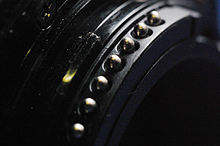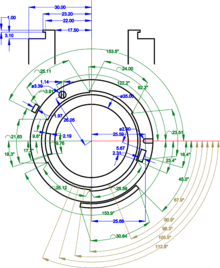F bayonet
The F bayonet is a lens mount system from the Japanese manufacturer Nikon . It is used to connect lenses to analog or digital SLR cameras . The F bayonet was introduced in 1959 with the in-house Nikon F camera .
Word origin
At the time of the introduction of the Nikon F model and its bayonet, SLR cameras were often referred to as "R" for reflex. As the "R" is not pronounced phonetically internationally uniform, they chose the letters identifying the new system F from re F from lex.
Characteristics
The F bayonet has a diameter of 44 mm and - in contrast to the systems from most other manufacturers - is connected in a counterclockwise direction. Because of the comparatively large flange focal length of 46.5 mm for 35mm cameras , it is difficult and not very common to adapt 35mm lenses that were not designed for the F bayonet to the F bayonet. There are various adapter solutions that either contain an additional optical element to compensate for a shorter flange focal length, or one loses the ability to focus the lens at infinity. Lenses that are designed for a larger back focus (e.g. for the medium format) can be adapted without this restriction.
The special thing about this system is the extensive compatibility of the lenses and cameras over a longer period of time. The Nikon F bayonet is one of only two lens systems (along with the K bayonet from Pentax) that was not discontinued with the introduction of autofocus . Instead, it has been further developed to meet the new technical requirements. The Nikon Df and the current top model Nikon D5 can use almost all lenses that also fit the first Nikon F. The wide variety of compatible lenses means that the F bayonet is the largest system of interchangeable lenses for single-lens reflex cameras (SLR) to date . Over 400 different Nikkor lenses with different functionality can be used with it.
In addition to Nikon itself, compatible lenses are manufactured by Sigma , Tamron , Tokina (autofocus), Carl Zeiss and Samyang (manual) and Schneider-Kreuznach (tilt-shift) and sold under various trademarks such as Voigtländer or Walimex. The company Fujifilm introduced compatible digital SLR cameras with Nikon F mount ago (S1 to S5 Pro Pro), as well as Kodak (DCS Pro 14n and DCS Pro SLR / n).
Data transfer
Nikon uses up to 10 electrical contacts to transfer data between the camera, lens and possibly teleconverter. You can differentiate between three different generations of data transmission: The Nikon F3 AF camera housing uses 6 pins, Ai-P and AF 5 pins and AF-I / AF-S 7 to 10 pins. Pins 8 to 10 only exist on some AF-I, AF-S and E lenses.
The following assignments can be derived from various Nikon repair manuals:
| Pin code | F3 AF | Ai-P / AF | AF-I / AF-S |
|---|---|---|---|
| P1 | Power supply when light meter is active (VCC) (5 V DC) | ||
| P2 | Read / Write (RW1) | ||
| P3 | Near to Far | Serial clock from camera (CLK) | |
| P4 | Far to Near | Data, serial I / O | |
| P5 | x | x | Hotline, Pulse (RW2) |
| P6 | Relative distance | x | Power supply for AF-S motor (VCC) |
| P7 | Ground (GND) | ||
| P8 | x | x | only with some AF-S lenses, hotline, pulse |
| P9 | x | x | only with some AF-S lenses |
| P10 | x | x | only with some AF-S lenses |
| Mount | - | - | Ground (GND) |
x = pin not available
historical development
The bayonet has been changed and further developed by the manufacturer over the years in order to be able to offer cameras and lenses with new features.
In 1959, the bayonet was introduced with the Nikon F camera model . It essentially served a mechanically solid connection and, in addition to its purely optical function, was not designed for the transmission of other parameters. The aperture information of the lens could still be transferred to a slide on the camera by means of a metal attachment on the aperture ring, the so-called “Nikon fork”.
From 1977 the light intensity of the lens could be transmitted to the light meter of the camera. In addition, the aperture information was from now on transmitted via a cam on the rear of the aperture ring of the lens. This can move a slider on the camera. The function was supported by the newly introduced Ai lenses.
From 1982 the aperture of the lens could be controlled by the automatic exposure of the camera. This was introduced with the Nikon F-301 and Nikon FA models.
The first autofocus functionality was implemented in April 1983. It was based on a focusing motor built into the lens. The auto focus was offered with the Nikon F3 AF camera model and two F3 AF lenses.
In 1986 the autofocus mechanism was changed. The focusing mechanism was now driven by an electric motor in the camera's housing, which is connected to the lens via a mechanical coupling, similar to a slotted screwdriver. The autofocus was offered with the Nikon F-501 camera model and various lenses.
From 1992 it was possible with D lenses to transfer the distance to the photo object from the lens to the light meter in the camera. This enabled better exposure and flash exposure metering. D lenses were introduced along with the Nikon F90 camera model .


